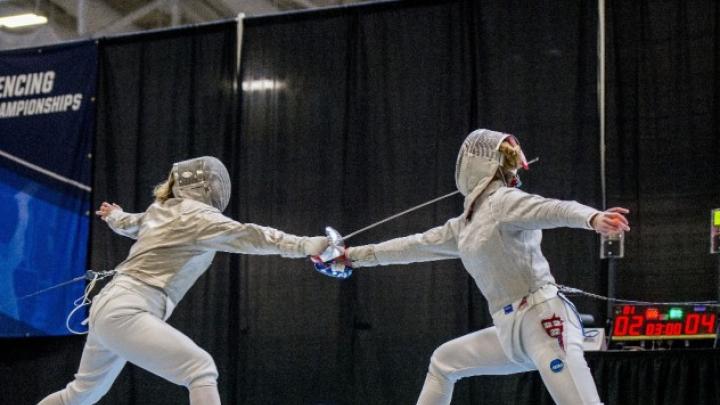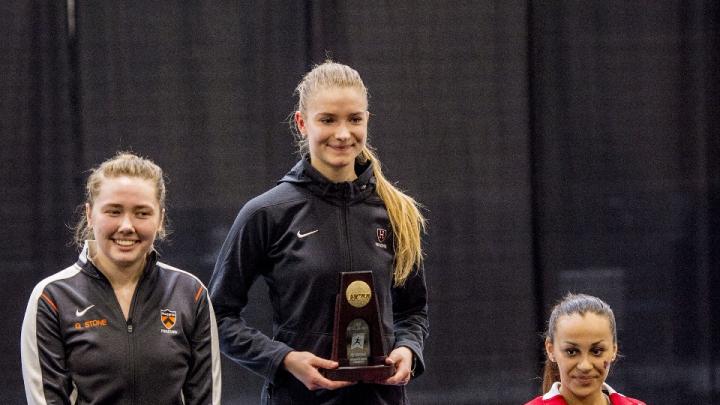In late March, after winning 19 of 23 bouts in a two-day round-robin tournament, Harvard junior Adrienne Jarocki was crowned NCAA champion in saber fencing, regaining a title she first won two years ago as a freshman. (In last year’s NCAAs, she brought home bronze.) “It was really sweet,” Jarocki says. A native of Queens, New York, and the only child of Polish immigrants, she is also a former childhood beauty queen and champion ballroom dancer. She came to fencing relatively late; at 13 years old, having suddenly outgrown her dance partner by several inches, she was looking for a new pursuit when her mother came across an ad for a fencing school in the pages of a Polish newspaper. Curiosity turned into commitment, and before long she was taking the subway to practice every day after school.
In her junior year of high school, Jarocki began competing in international tournaments, and as a high-school senior she was a member of the USA Junior National Team. Her weapon, the saber, with its V-shaped blade, is used for cutting and slashing, and until the 1980s it was not officially sanctioned in women’s competitions—the United States Fencing Association considered it too heavy and dangerous, compared to the lighter, smaller foil.
At Harvard, Jarocki balances fencing with a pre-med curriculum and work in the laboratory of Chad Cowan, associate professor of stem-cell and regenerative biology; she will graduate next year with a degree in human evolutionary biology and is applying to medical school.
Recently she sat down with Harvard Magazine to talk fencing weapons, beauty pageants, and battle screams. The interview is condensed and edited below.
What first appealed to you about fencing?
The individuality. That I wasn’t depending on anybody else. And I liked the unpredictability of it. Ballroom dancing is all routines, and this is a sport where you never know what is going to happen; you never know what reaction it’s going to cause in your opponent. And so every single bout is different.
Why do you fence saber, rather than épée or foil?
I just happened to choose that by accident. But it’s the best weapon for me, because I’m not really very patient, and saber requires no patience. You just start running after each other.
Is there trash-talking in fencing?
Well, there’s a lot of screaming. After you get a point, it’s like a celebration scream—or I guess it’s more of a shriek.
Do you shriek?
Definitely.
Does it help?
I think so. It definitely makes your body feel ready to perform.
What do you scream?
Whatever comes out.
What makes a person good at fencing?
It’s a lot of hand-eye coordination. And trained reflexes—I wouldn’t necessarily say that my reflexes are faster than somebody else’s, but my fencing reflexes are faster.
What are fencing reflexes?
Like, if you see somebody’s going to hit at your torso, you automatically block it. And this block has to be at the right angle and a specific position, because if not, they’ll just end up hitting you anyway. So being able to make that move without thinking about it.
At Harvard, the men’s and women’s teams practice against each other.
That’s normal for all clubs, all countries, any type of training facility you go to. Men’s and women’s fencing is sort of similar to men’s and women’s tennis, in that they can play against each other competitively. But women and men have different strengths in their game.
Like what?
Men move a lot more, so they’re utilizing more of the strip [the playing area in fencing]. If you’re fencing a man, it can be a really great way to improve your footwork and your endurance, so that you’ll be able to constantly grind your opponent up and down the strip. Meanwhile, women are really good at counterattacking and hitting their opponent in preparation.
What’s the first thing to learn when you’re starting to watch the sport?
The three different weapons have different target areas. The épée and foil are thrusting weapons, and at the end of the blade there’s a pen-tip-type cap that has to click in order for the light to go on that registers a hit—all this is electronically scored. But saber is a slashing weapon. All I need to do is touch you—no force at all—and my light would go on. But probably 90 percent of the time, both lights go on, because both opponents made a hit. And then the point is determined by who has right of way. That’s why there’s a referee. If one fencer is attacking and moving forward when both opponents hit the other, then it’s the attacker’s point. But if you do anything to disrupt the attacker—block their blade, hit their blade and make them miss—and you both hit, then it’s your point.
Do you have a favorite fencer, someone to watch for in the 2016 Olympics?
Olha Kharlin from Ukraine. She hasn’t performed as well this year, but she’s one of the top senior women’s fencers. She has a really nice style.
Is there much overlap between ballroom dancing and fencing footwork?
Not really, although I’ve been told I have a unique footwork style, that it looks almost like dancing. But I did gain a lot from beauty pageants, which I did for two years when I was younger. People have a very negative impression of pageants, but I competed with an organization called National American Miss, and in the division I was in, pre-teen, you’re not allowed to wear any makeup. The competition has a lot to do with community service. That’s part of your score, along with the interview and a formalwear segment. I learned a lot of confidence from pageants, and how to speak publicly at a young age.
What’s next for you and fencing?
It depends. If I’d taken time off from school, I think I could have qualified for this year’s Olympics [as Harvard men’s saber fencer Eli Dershwitz ’18 did; he’ll join the U.S. team in Rio de Janeiro this August]. But I decided to stay here and try to get into med school and then see what happens. A lot will boil down to who retires after these Olympic Games, and what the field is going to look like. And also where I get into med school and what my training options are.
Best thing about fencing?
Winning. You drop to the floor and throw all your stuff, rip your mask off and throw the saber. And the strip is lit up. It’s so cool. Such a great feeling.
And you scream?
And you scream.









